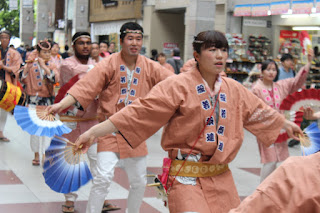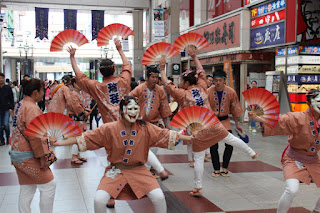"Naruhodo" means here "that must be fun!" in Japanese and "Naruhodo Magazine" is the special page started this spring in "Kahoku Weekly Sendai", a weekly freepaper magazine published by "Kahoku Shimpo", a japanese newspaper company, in Sendai, Miyagi.
2016年7月26日火曜日
2016年7月25日月曜日
AOBA MATSURI in SENDAI
Report:
Arunava Acharyya (india)
On
14th May, I had the chance to see Aoba Matsuri for the second time since I have
come to Sendai. That said, it was a bit different this time in the way I
experienced the festival. This time around I had the chance to dance in the
festival with other Japanese people in the street. This dance known as the
Sparrow dance has been performed since 400 years in Sendai and I was lucky to
be a part of this long history.
 This
experience started with a practice session on 12th May at Yagiyama Shimin
Centre. Me and and my friend from China went together for the practice session.
When we arrived, there were already some people there and the practice had
already started. After sometime, we received the clothes in which we would
dance in the festival. After that we were told to join in the dancers and
follow their style and I am afraid they were way better than us. But
nevertheless we gave it a shot.
This
experience started with a practice session on 12th May at Yagiyama Shimin
Centre. Me and and my friend from China went together for the practice session.
When we arrived, there were already some people there and the practice had
already started. After sometime, we received the clothes in which we would
dance in the festival. After that we were told to join in the dancers and
follow their style and I am afraid they were way better than us. But
nevertheless we gave it a shot.
The teacher was kind enough
to help us in learning the basic moves of the dance. About 20 minutes later we
were told to take a break for around 10 minutes. During this time we interacted
with other people of the dance group. Then we started our 2nd and last session
of practice which lasted for another 15-20 minutes. After the dance session got
over, we changed back into our clothes and returned back feeling excited about
the upcoming dance on Saturday, that is, on 14th May.
Saturday
was a warm day with a bit of wind which made it easy to wear the traditional Japanese
clothes required for dancing in the festival. I had worn Yukata before but it
was first time wearing Happi. We had
already changed into our dance clothes and we reached near the starting point
where we were asked to meet. When we reached there, we saw that there were many
other groups lining up to dance before or after us. Also, we had been joined by
two more people, one of whom, had come all the way from Tokyo to participate in
this festival. We had half an hour before we started our dance so I spent this
time talking to other members of the group and getting to know them better. We
took some photos before we started our dance. Our dance started at around 1:30
pm at the entrance of the arcade.
At first, when we started I
started feeling a bit shy because I didn’t know the dance well. On top of that
there were hundreds of people looking. But as the dance progressed, I started
getting some confidence as I saw others dancing with each other. By the time we
reached the next intersection of roads and had to stop to cross, I was feeling
very confident to continue the dance.
 I
had support from other dancers who were encouraging me constantly throughout
the dance. We changed our positions while dancing and had to dance the whole
length of the arcade which is about 1.5 kilometres. The most interesting thing
was that this was the first time I crossed the whole arcade by dancing and not
by walking. After the dance got over, we exchanged our contacts and took our
farewell from the dance group.
I
had support from other dancers who were encouraging me constantly throughout
the dance. We changed our positions while dancing and had to dance the whole
length of the arcade which is about 1.5 kilometres. The most interesting thing
was that this was the first time I crossed the whole arcade by dancing and not
by walking. After the dance got over, we exchanged our contacts and took our
farewell from the dance group. By
the time we finished it was well past our lunch time so we decided to go for
lunch at an Indian restaurant named Ashirvad which is inside the arcade. The
lunch was good especially since we were starving. After a heavy lunch we were
going back to change our clothes during which time we came across a shop
selling Hyoutan-age. This food is made from fish paste and we couldn’t resist
trying one of these. So in spite of having a heavy lunch we ate one Hyoutan-age
each. The Hyotan-age was a bit sweet because of the fish paste but with the
crunchiness of a fry. With this, the perfect day ended with a perfect food and made
me experience some more of the rich culture of Japan especially Sendai.
By
the time we finished it was well past our lunch time so we decided to go for
lunch at an Indian restaurant named Ashirvad which is inside the arcade. The
lunch was good especially since we were starving. After a heavy lunch we were
going back to change our clothes during which time we came across a shop
selling Hyoutan-age. This food is made from fish paste and we couldn’t resist
trying one of these. So in spite of having a heavy lunch we ate one Hyoutan-age
each. The Hyotan-age was a bit sweet because of the fish paste but with the
crunchiness of a fry. With this, the perfect day ended with a perfect food and made
me experience some more of the rich culture of Japan especially Sendai.仙台・青葉まつり
リポーター:アルナバ
アチャーリャ(インド)
5月14日、仙台に来てから2度目の「仙台・青葉まつり」を見る機会がありました。と言っても、まつりの体験の仕方が今度は少し違いました。今回は、商店街通りで日本の方々と一緒にまつりで踊ることになったのです。「すずめ踊り」として知られるこの踊りは、仙台で400年も前から行われてきたといいます。私はその長い歴史の一部に触れることができてラッキーでした。
今回の「すずめ踊り」体験は、5月12日、八木山市民センターでの練習会から始まりました。私は中国人の友人と一緒に練習会に参加しました。私たちが到着したとき、すでに何人かが練習を開始していました。
しばらくしてから、私たちはまつりで踊るときに着るための衣装を受け取りました。その後、踊り手さんたちと一緒に、やり方を見ながら参加してみるよう言われましたが、彼らは私たちよりもずっと上手です。それでも私たちはやるしかありません。 先生は「すずめ踊り」の基本の動きを学ぼうとしている私たちに親切に教えてくれました。20分ほど練習し、10分ほど休憩です。休憩の間に(すずめ踊りの)グループの方々と話をしました。そしてまた2回目、3回目の練習を15~20分ずつ行い、練習会は終了となりました。私たちは着替えをし、5月14日土曜日、もうすぐ開催される本番を思ってワクワクしながら帰りました。
土曜日は風も強くなく暖かい日で、「すずめ踊り」用の日本の伝統的な衣装を着るのにちょうどよかったです。浴衣は着たことがありますが「半被」を着るのは初めてです。私たちは早々に「すずめ踊り」用の衣装に着替え、待ち合わせ場所の出発地点に到着していました。私たちの前にも後ろにも、たくさんのグループが並んでいました。また、私たちのチームにもう2人参加したのですが、そのうちの一人はこのまつりに参加するために東京からはるばる来ていました。私たちが踊り始めるまでに30分ほど時間があったので、自分たちのグループの他のメンバーと話をしながら過ごし、より親しくなることができました。踊りが始まる前に写真も撮りました。私たちの「すずめ踊り」はハピナ名掛丁商店街のアーケード入口から午後1時30分頃に始まりました。最初のうちは、踊りがよくわからずに少しためらいがありました。その上、たくさんの人たちが見ているのです。それでも踊り進めていくうちに、他の人たちの踊りをお互いに見ながら、私もだんだん自信がでてきました。次の交差点に出て信号待ちをする頃には、かなり自信が持てるようになりました。踊っている最中ずっと励ましてくれた他のメンバーたちのおかげでもあります。私たちは踊りながら位置を変え、約1.5kmある長いアーケードをずっと踊って進んでいかなくてはなりません。アーケード全体を歩いてではなく踊りながら通ったのは初めてで、何よりもおもしろい体験でした。踊り切った後、私たちはすずめ踊りグループのみなさんと連絡先を交換して別れました。
「すずめ踊り」が終わった頃にはお昼時間をとっくに過ぎていました。私たちはアーケード内にある「AASHIRWAD」というインド料理店に行くことにしました。とても空腹だったせいもあり、ランチはおいしかったです。ボリュームのあるランチを食べた後、着替えをするために戻っていたら「ひょうたん揚げ」を売っているお店に行き当たりました。「ひょうたん揚げ」は魚のすり身から作られています。わたしたちは食べてみずにいられませんでした。たっぷりランチを取った後でしたが、私たちはみんな「ひょうたん揚げ」を1本ずついただきました。魚のすり身がほんのりと甘い、カリッとした揚げ物です。このように、その日は日本、とりわけ仙台の豊かな文化について体験することができ、すばらしくおいしい食べ物で締めくくった完璧な日になりました。
Sendai-suzume-odori (sparrow-dance in sendai)
Reporter:
Jiang Nan (China)
My impression on the aoba
matsuri last year
Last year, I happened to see the aoba matsuri when it was
my first year staying in Japan. Although I cannot remember all the details of
the matsuri, it still left me a great impression.
There were so many teams of people that day, wearing very
Japanese-style costumes, dancing along the ichibancho. The dance was
interesting and impressive because it looks like sparrow, jumping up and down.
The music which was played by some Japanese traditional instruments like taiko
drums, flutes and so on was very different from modern music but easy to remember.
I stood there and listened for several times and I couldn’t get rid of the
melody from my mind even! The music sounded bright and lively, and so maybe
because of this reason, it provided an extremely joyful tmosphere to the
festival. People inside ichibancho, no matter he or she danced or just the
audience, unlike in normal days, being elegant but all wearing a large smile.
However, it was really a pity last year because I didn’t
join the festival but just saw people dancing. It then became one of my wishes
which I wanted to do during my stay here. I believe participating in such kind
of traditional festival makes me, a foreign student, to know Japanese life
better and also gives me opportunity to get close to Japanese culture. So this
year, when I heard the newspaper company would let me dance in aoba matsuri, I
felt so excited. Finally my wish could come true!
Practice of the suzume-odori
Two days before aoba matsuri, we were led to a 市民会館 to learn and practice the
suzume-odori there. There was also a professional dancing team there
practicing.
The dance looked quite simple, but when it was my turn to do it, I finally
realized it was so hard. The steps, the music rhythm, the two different colors
of the fans, the way to shave the fans and also we had to bend our knees all
the time, so many things mixed together and we had to take care. At first, it
was really hard for me to get used to it. Fortunately, under the patient instruments
from the sensei and also some help from other members inside the team, after
practice and practice, I was even praised by the sensei, which made me feel
really happy.
The day on aoba matsuri
On
the day of Aoba matsuri, I got up very early, can't wait to participate in the
festival. In the noon, I went to 河北新報 to try my happi on. The costume was so cute and looked
traditional and also full of Japanese style. But it was little bit 難しいfor me to wear, especially waistband part I had no idea how to
put it on at all. So later, the team leader helped me with that. And she also
told me the waistband was not supposed to pull up to the waist, but always to
pull it down to the hipbone. That made the costume looked unique and had its
own characteristic.
And later
we waited in a square for the performance. There were also several other teams
waiting, some from companies, some from some restaurants.
Finally, it was time for our team. We stood in a line and
went to the starting point, with excitement and nervousness. With the music, we
began to dance. There were so many people and they all stopped to watch us
dancing. And most of them took pictures of us or the video. I felt little bit 恥ずかしいat first because of the audience
there and I found it so hard to dance while I still needed to move forward. But
later, after getting used to it, I felt so excited to dance among the crowd.
And for some part of the dance, we could even create our own movements, just
like free-style dance, to make it livelier. After dancing for about half an
hour, I felt much hotter and tired than I had expected. But, I felt so happy as
well.
After it finished, we took lots of pictures together with
the team members and exchanged Facebook.
ひょうたんあげ

After lunch, we had hyoutan-age, which is one of the 仙台名物. The shop is located in Ihibancho, which is called 阿部蒲鉾店. The shop is so famous that I always see lots of people waiting in a line in order to buy it. According to its name, hyoutan means gourd in Japanese because it really looks like the deep flied gourd with two parts up and down, and each part is a ball. Hyoutan-age is a kind of food which has boiled fish called kamaboko inside mixed with deep flied paste outside. So when I tasted it, it was hard from outside but very soft inside. And the taste was not so sweet and not so salty, but ちょうどいい. And I liked it very much. I think I will come and buy often later.
仙台すずめ踊り
リポーター:ジャン ナン(中国)
去年の「仙台・青葉まつり」の印象
日本に来て1年目の去年、たまたま「仙台・青葉まつり」を見ました。まつりの詳しいことまでは覚えていませんが、とても印象的だったことは今も覚えています。
その日はたくさんの参加チームが、まさに日本といった感じの衣装を着て一番町通りで踊っていました。興味深く、印象的な踊りでした。飛び跳ねる様子が雀のように見えるのです。太鼓や笛など日本の伝統的な楽器で演奏されるお囃子は、現代的な音楽とはまったく違いますが、記憶に残ります。何度か立ち止まって耳を傾けていると、頭の中にそのメロディが残って抜けていかなくなったほどです。お囃子が明るく陽気な響きであることも、まつりをとても楽しい雰囲気にしているのだと思います。一番町通りで、男性・女性にかかわらず人々が踊っていて、見ている人たちも普段とは違って笑顔でいっぱいでした。
でも、去年は自分がまつりに参加したわけではなく、踊っている人たちを見ているだけだったことが本当に残念でした。それ以来、日本にいる間にやってみたいことのひとつになったのです。外国人留学生として、そういった伝統的なまつりに参加することは日本の生活をより知ることになるし、日本の文化に親しむいい機会になるに違いないと考えたからです。だから今年、新聞社から「仙台・青葉まつり」で踊りに参加させてもらえると聞いたとき、とてもわくわくしました。私の願いがついに叶うのです!
すずめ踊りの練習
「仙台・青葉まつり」の2日前、私たちは市民会館ですずめ踊りを教えてもらい、練習することになりました。そこでは経験豊かなすずめ踊りチームも練習していました。
踊りはきわめてシンプルに見えたのですが、実際に自分の練習の番になると、とても難しいことがわかりました。ステップ、リズムにのること、2つの違う色の扇子とその振り方……それに、私たちはずっとひざを曲げていなければなりません。たくさんのことを同時に行わなければなりません。最初、慣れるまでは本当に難しかったです。幸い、先生が辛抱強く教えてくれ、チームのみなさんにも助けていただきました。そして練習に練習を重ね、先生に褒められるようになったときには本当にうれしくなりました。
「仙台・青葉まつり」当日
「仙台・青葉まつり」の当日はとても早く起きました。まつりに参加するのが待ちきれなかったのです。昼頃に河北新報社に行き、「はっぴ」を着ました。衣装は格好良く、伝統的でまさに日本風。けれども「はっぴ」を着るのは私にとって少し難しかったです。特に帯をどのように結べばいいのかさっぱりわかりません。後からチームリーダーが手伝ってくれました。彼女は、帯はウエストの位置ではなく腰骨のあたりまで下げて締めるものだと教えてくれました。こうすると衣装が独特で特徴的な印象になります。その後、私たちは広場で演舞の順番を待ちました。他にも数チームが待っています。企業のチームも、レストランのチームもいました。
ついに私たちチームの番になりました。私たちは列になって出発点に向かいます。興奮と緊張でいっぱいです。お囃子とともに私たちは踊り始めました。まつりにはたくさんの人が出ていて、みんな立ち止まって私たちのすずめ踊りを見ています。ほとんどの人が写真や動画を撮っています。お客さんがいるので最初は少し恥ずかしかったですし、踊りながら前に進んでいかなければならず、とても難しかったです。それでもしばらくして慣れてくると、お客さんたちの前で踊ることが楽しくなってきました。途中で、より溌剌とした動きに見えるよう、フリースタイルダンスのように自分たちなりの動きを作り出して踊ることすらできるようになりました。30分ほど踊ると、想像以上に暑くなって疲れてきましたが、同じくらい楽しくてなりませんでした。
踊り終わった後、私たちはチームのみなさんと一緒にたくさんの写真を撮り、Facebookのアカウントを交換しました。
ひょうたん揚げ
お昼ご飯のあと、仙台名物のひとつである「ひょうたん揚げ」を食べに行きました。店は「阿部蒲鉾店」といって一番町にあります。有名な店で、いつもたくさんの人が並んでいます。日本語でひょうたんは「gourd(=ひょうたん)」のことです。2つの球状のものを上下に並べて揚げたもので、ひょうたんを揚げたように見えます。「ひょうたん揚げ」は魚(のすり身)を蒸して作られる「かまぼこ」の外側に衣をつけて揚げた食べ物です。外側はカリッとしていて、中はとてもふんわりとしています。甘すぎず、しょっぱすぎず、ちょうどいい味。とても気に入りました。また今度買いに行こうと思っています。
登録:
コメント (Atom)











